Pool Boiling of Nanofluids on Biphilic Surfaces: An Experimental and Numerical Study
Abstract
:1. Introduction
2. Materials and Methods
2.1. Nanofluid Preparation
2.2. Biphilic Surfaces Preparation
2.3. Surface and Fluid Characterization
2.4. Experimental Setup
2.5. Numerical Method
2.5.1. Numerical Model
2.5.2. Geometry and Mesh
2.5.3. Transport Properties, Initial and Boundary Conditions
3. Results and Discussion
4. Conclusions
Supplementary Materials
Author Contributions
Funding
Acknowledgments
Conflicts of Interest
References
- Maia, I.; Rocha, C.; Pontes, P.; Cardoso, V.; Miranda, J.; Moita, A.; Minas, G.; Moreira, A.L.N.; Lima, R. Heat Transfer and Fluid Flow Investigations in PDMS Microchannel Heat Sinks Fabricated by Means of a Low-Cost 3D Printer. Adv. Microfluid. Technol. Energy Environ. Appl. 2020. [Google Scholar] [CrossRef]
- Qiu, L.; Zhu, N.; Feng, Y.; Michaelides, E.E.; Żyła, G.; Jing, D.; Zhang, X.; Norris, P.M.; Markides, C.N.; Mahian, O. A review of recent advances in thermophysical properties at the nanoscale: From solid state to colloids. Phys. Rep. 2020, 843, 1–81. [Google Scholar] [CrossRef]
- Choi, S.U.S. Enhancing Thermal Conductivity of Fluids with Nanoparticles. In Proceedings of the ASME International Mechanical Engineering Congress and Engineering Congress and Exposition, San Francisco, CA, USA, 12–17 November 1995; pp. 99–105. [Google Scholar]
- Asadi, A.; Aberoumand, S.; Moradikazerouni, A.; Pourfattah, F.; Żyła, G.; Estellé, P.; Mahian, O.; Wongwises, S.; Nguyen, H.M.; Arabkoohsar, A. Recent advances in preparation methods and thermophysical properties of oil-based nanofluids: A state-of-the-art review. Powder Technol. 2019, 352, 209–226. [Google Scholar] [CrossRef]
- Almurtaji, S.; Ali, N.; Teixeira, J.A.; Addali, A. On the Role of Nanofluids in Thermal-hydraulic Performance of Heat Exchangers—A Review. Nanomaterials 2020, 10, 734. [Google Scholar] [CrossRef] [Green Version]
- Sajid, M.U.; Ali, H.M. Recent advances in application of nanofluids in heat transfer devices: A critical review. Renew. Sustain. Energy Rev. 2019, 103, 556–592. [Google Scholar] [CrossRef]
- Sadeghi, M.S.; Anadalibkhah, N.; Ghasemiasl, R.; Armaghani, T.; Dogonchi, A.S.; Chamkha, A.J.; Ali, H.; Asadi, A. On the natural convection of nanofluids in diverse shapes of enclosures: An exhaustive review. J. Therm. Anal. Calorim. 2020, 1–22. [Google Scholar] [CrossRef]
- Lomascolo, M.; Colangelo, G.; Milanese, M.; De Risi, A. Review of heat transfer in nanofluids: Conductive, convective and radiative experimental results. Renew. Sustain. Energy Rev. 2015, 43, 1182–1198. [Google Scholar] [CrossRef]
- Asadi, A.; Pourfattah, F.; Szilágyi, I.M.; Afrand, M.; Żyła, G.; Ahn, H.S.; Wongwises, S.; Nguyen, H.M.; Arabkoohsar, A.; Mahiana, O. Effect of sonication characteristics on stability, thermophysical properties, and heat transfer of nanofluids: A comprehensive review. Ultrason. Sonochemistry 2019, 58, 104701. [Google Scholar] [CrossRef]
- Asadi, A.; Alarifi, I.M. Effects of ultrasonication time on stability, dynamic viscosity, and pumping power management of MWCNT-water nanofluid: An experimental study. Sci. Rep. 2020, 10, 1–10. [Google Scholar] [CrossRef]
- Ali, N.; Teixeira, J.A.; Addali, A. Aluminium Nanofluids Stability: A Comparison between the Coventional Two-Step Fabrication Approach and the Controlled Sonication Bath Temperature Method. J. Nanomater. 2019, 2019, 3930572. [Google Scholar] [CrossRef] [Green Version]
- Guo, D.-S.; Li, X.-B.; Zhang, H.-N.; Li, F.-C.; Su, W.-T.; Zhu, H. Bubble behaviors duringsubcooled pool boiling in water and nonionic surfactant aqueous solution. Int. J. Heat Mass Trans. 2020, 159, 120087. [Google Scholar] [CrossRef]
- Gan, Y.Y.; Ong, H.C.; Ling, T.C.; Zulkifli, N.; Wang, C.-T.; Yang, Y.-C. Thermal conductivity optimization and entropy generation analysis of titanium dioxide nanofluid in evacuated tube solar collector. Appl. Therm. Eng. 2018, 145, 155–164. [Google Scholar] [CrossRef]
- Mousavi, S.; Esmaeilzadeh, F.; Wang, X. A detailed investigation on the thermo-physical and rheological behavior of MgO/TiO2 aqueous dual hybrid nanofluid. J. Mol. Liq. 2019, 282, 323–339. [Google Scholar] [CrossRef]
- Ajeel, R.K.; Salim, W.S.-I.; Hasnan, K. Experimental and numerical investigations of convection heat transfer in corrugated channels using alumina nanofluid under a turbulent flowregime. Chem. Eng. Res. Design 2019, 148, 202–217. [Google Scholar] [CrossRef]
- Krishnakumar, T.S.; Sheeba, A.; Mahesc, V.; Prakash, M.J. Heat transfer studies onethylene glycol/water nanofluid containing TiO2 nanoparticles. Int. J. Refrig. 2019, 102, 55–61. [Google Scholar] [CrossRef]
- Singh, A.; Sharma, S.; Gangacharyulu, D. Nanofluids Preparation and Stability for HeatTransfer Applications—A Review. Int. J. Comp. Appl. 2016, 975, 8887. [Google Scholar]
- Das, S.K.; Choi, S.U.; Yu, W.; Pradeep, T. Nanofluids: Science and Technology; John Wiley & Sons: Hoboken, NJ, USA, 2007; 485p. [Google Scholar]
- Tuesta, J.L.D.; Machado, B.F.; Serp, P.; Silva, A.M.T.; Faria, J.L.; Gomes, H.T. Janusamphiphilic carbon nanotubes as Pickering interfacial catalysts for the treatment of oily wastewater by selective oxidation with hydrogen peroxide. Catal. Today 2020, 356, 205–215. [Google Scholar] [CrossRef] [Green Version]
- Rodrigues, R.O.; Bañobre-López, M.; Gallo, J.; Tavares, P.B.; Silva, A.M.T.; Lima, R.A.; Gomes, H.T. Haemocompatibility of iron oxide nanoparticles synthesized for theranostic applications: A high-sensitivity microfluidic tool. J. Nanoparticle Res. 2016, 18, 1–17. [Google Scholar] [CrossRef] [Green Version]
- Rodrigues, R.O.; Sousa, P.; Gaspar, J.; Bañobre-López, M.; Lima, R.; Minas, G. Organ-on-a-chip: A Preclinical Microfluidic Platform for the Progress of Nanomedicine. Small 2020, 2003517. [Google Scholar] [CrossRef]
- Teodori, E.; Valente, T.; Malavasi, I.; Moita, A.; Marengo, M.; Moreira, A. Effect of extreme wetting scenarios on pool boiling conditions. Appl. Therm. Eng. 2017, 115, 1424–1437. [Google Scholar] [CrossRef] [Green Version]
- Bahaidarah, H.M.S.; Baloch, A.A.B.; Gandhidasan, P. Uniform cooling of photovoltaic panels: A review. Renew. Sustain. Energy 2016, 57, 1520–1544. [Google Scholar] [CrossRef]
- Može, M.; Zupančič, M.; Golobič, I. Pattern geometry optimization on superbiphilic aluminum surfaces for enhanced pool boiling heat transfer. Int. J. Heat Mass Transf. 2020, 161, 120265. [Google Scholar] [CrossRef]
- Lim, D.Y.; Bang, I.C. Controlled bubble departure diameter on biphilic surfaces for enhanced pool boiling heat transfer performance. Int. J. Heat Mass Transf. 2020, 150, 119360. [Google Scholar] [CrossRef]
- Betz, A.R.; Jenkins, J.; Kim, C.C.; Attinger, D. Boiling heat transfer on superhydrophilic, superhydrophobic, and superbiphilic surfaces. Int. J. Heat Mass Transf. 2013, 57, 733–741. [Google Scholar] [CrossRef] [Green Version]
- Buongiorno, J.; Cahill, D.G.; Hidrovo, C.H.; Moghaddam, S.; Schmidt, A.J.; Shi, L. Micro- and Nanoscale Measurement Methods for Phase Change Heat Transfer on Planar and Structured Surfaces. Nanoscale Microscale Thermophys. Eng. 2014, 18, 270–287. [Google Scholar] [CrossRef]
- Teodori, E.; Pontes, P.; Moita, A.S.; Moreira, A.L.N. hermographic analysis of interfacial heat transfer mechanisms on droplet/wall interactions with high temporal and spatial resolution. Exp. Therm. Fluid Sci. 2018, 96, 284–294. [Google Scholar] [CrossRef]
- Cheng, H.-C.; Jiang, Z.-X.; Chang, T.-L.; Chen, P.-H. Effects of difference in wettability level of biphilic patterns on copper tubes in pool boiling heat transfer. Exp. Therm. Fluid Sci. 2021, 120, 110241. [Google Scholar] [CrossRef]
- Shen, B.; Mine, T.; Iwata, N.; Hidaka, S.; Takahashi, K.; Takata, Y. Deterioration of boiling heat transfer on biphilic surfaces under very low pressures. Exp. Therm. Fluid Sci. 2020, 113, 110026. [Google Scholar] [CrossRef]
- Motezakker, A.R.; Sadaghiani, A.K.; Çelik, S.; Larsen, T.; Villanueva, L.G.; Koşar, A. Optimum ratio of hydrophobic to hydrophilic areas of biphilic surfaces in thermal fluid systems involving boiling. Int. J. Heat Mass Transf. 2019, 135, 164–174. [Google Scholar] [CrossRef]
- Sezer, N.; Atieh, M.A.; Koç, M. A comprehensive review on synthesis, stability, thermophysical properties, and characterization of nanofluids. Powder Technol. 2019, 344, 404–431. [Google Scholar] [CrossRef]
- Xuan, Y.; Roetzel, W. Conceptions for heat transfer correlation of nanofluids. Int. J. Heat Mass Transf. 2000, 43, 3701–3707. [Google Scholar] [CrossRef]
- Estellé, P.; Cabaleiro, D.; Zyla, G.; Lugo, L.; Murshed, S.M.S. Current trends in surface tensionand wetting behavior of nanofluids. Renew. Sustain. Energy Rev. 2018, 94, 931–944. [Google Scholar] [CrossRef]
- Pontes, P.; Qiu, J.L.; Matos, F.M.; Moita, A.L.N.; Ribero, A.P.C.; Moreira, A.L.N. Heat transfer and fluid dynamics of nanofluid droplets impacting on a smooth heated surface: Detailing temporal scale effects by using time-resolved thermography. Heat Transfer Eng. 2020. [Google Scholar] [CrossRef]
- Figueiredo, M.; Marseglia, G.; Moita, A.S.; Panão, M.R.O.; Ribeiro, A.P.C.; Medaglia, C.M.; Moreira, A.L.N. Thermofluid characterization of nanofluid spray cooling combining phase Doppler Interferometry with high-speed visualization and time-resolved IR thermography. Energies 2020, 13, 5864. [Google Scholar] [CrossRef]
- Maxwell, J.C. A Treatise on Electricity and Magnetism; Cambridge University Press: Cambridge, UK, 1873. [Google Scholar] [CrossRef] [Green Version]
- Li, C.H.; Peterson, G.P. Experimental investigation of temperature and volume fraction variations on the effective thermal conductivity of nanoparticle suspensions (nanofluids). J. Appl. Phys. 2006, 99, 084314. [Google Scholar] [CrossRef]
- Li, C.H.; Peterson, G.P. The effect of particle size on the effective thermal conductivity of Al2O3-water nanofluid. J. Appl. Phys. 2007, 101, 044312. [Google Scholar] [CrossRef]
- Ruey-Hung, C.; Phuoc, T.X.; Donald, M. Surface tension of evaporating nanofluid droplets. Int. J. Heat Mass Transf. 2011, 54, 2459–2466. [Google Scholar]
- Pereira, P.M.M.; Moita, A.S.; Monteiro, G.A.; Prazeres, D.M.F. Characterization of the topography and wettability of English weed leaves and biomimetic replicas. J. Bionic Eng. 2014, 11, 346–359. [Google Scholar] [CrossRef]
- Moita, A.; Laurência, C.; Ramos, J.A.; Prazeres, D.M.F.; Moreira, A.L.N. Dynamics of droplets of biological fluids on smooth superhydrophobic surfaces under electrostatic actuation. J. Bionic Eng. 2016, 13, 220–234. [Google Scholar] [CrossRef]
- Nabil, M.; Rattner, A.S. Interthermalphasechangefoam-a framework for two-phase flow simulations with thermally driven phase change. SoftwareX 2016, 5, 216–226. [Google Scholar] [CrossRef] [Green Version]
- Versteeg, H.K.; Malalasekera, W. An Introduction to Computational Fluid Dynamics: The Finite Volume Method; Prentice Hall: London, UK, 2007. [Google Scholar]
- Alhendal, Y.; Tur, A. Volume-of-Fluid (VOF) Simulations of Marangoni Bubbles Motion in Zero Gravity. In Finite Volume Method-Powerful Means Engineering Design; Intechopen: London, UK, 2012; pp. 215–236. [Google Scholar] [CrossRef] [Green Version]
- Brackbill, J.U.; Kothe, D.B.; Zemach, C. A continuum method for modeling surface tension. J. Comput. Phys. 1992, 100, 335–354. [Google Scholar] [CrossRef]
- Georgoulas, A.; Andredaki, M.; Marengo, M. An enhanced VOF method coupled with heat transfer and phase change to characterise bubble detachment in saturated pool boiling. Energies 2017, 10, 272. [Google Scholar] [CrossRef] [Green Version]
- Rattner, S. Single-Pressure Absorption Refrigeration Systems for Low-Source-Temperature Applications. Ph.D. Thesis, Georgia Institute of Technology, Atlanta, GA, USA, 2015. [Google Scholar]
- Berg, J. Hydrodynamics of Wetting. Wettability 1993, 6, 327–446. [Google Scholar] [CrossRef]
- Pontes, P.; Cautela, R.; Teodori, E.; Moita, A.; Liu, Y.; Moreira, A.; Nikulin, A.; Del Barrio, E.P. Effect of pattern geometry on bubble dynamics and heat transfer on biphilic surfaces. Exp. Therm. Fluid Sci. 2020, 115, 110088. [Google Scholar] [CrossRef]
- Wang, D.; Quan, X.; Liu, C.; Cheng, P. An experimental investigation on periodic single bubble growth and departure from a small heater submerged in a nanofluid containing moderately hydrophilic nanoparticles. Int. Commun. Heat Mass Transf. 2018, 95, 1–8. [Google Scholar] [CrossRef]

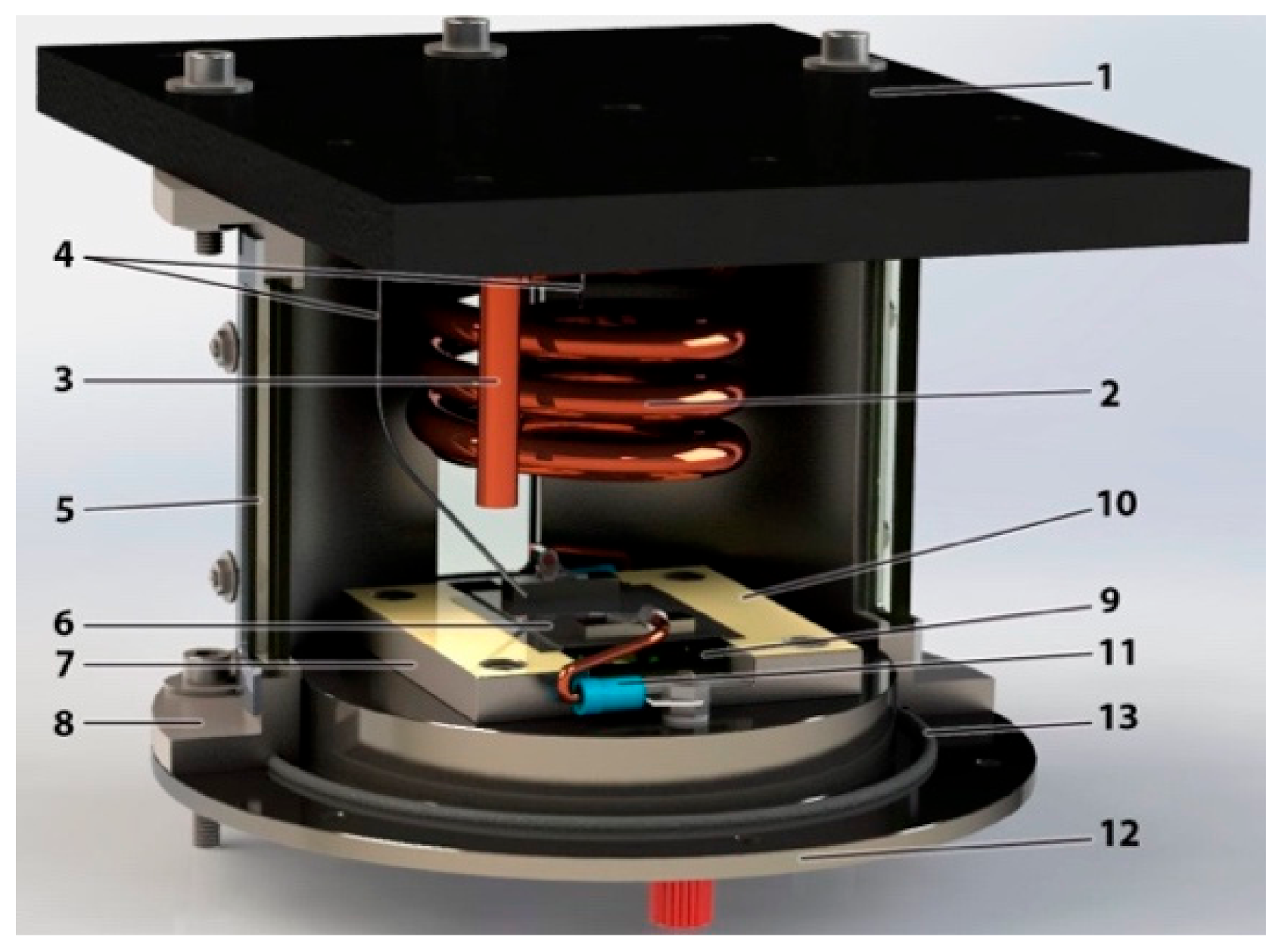
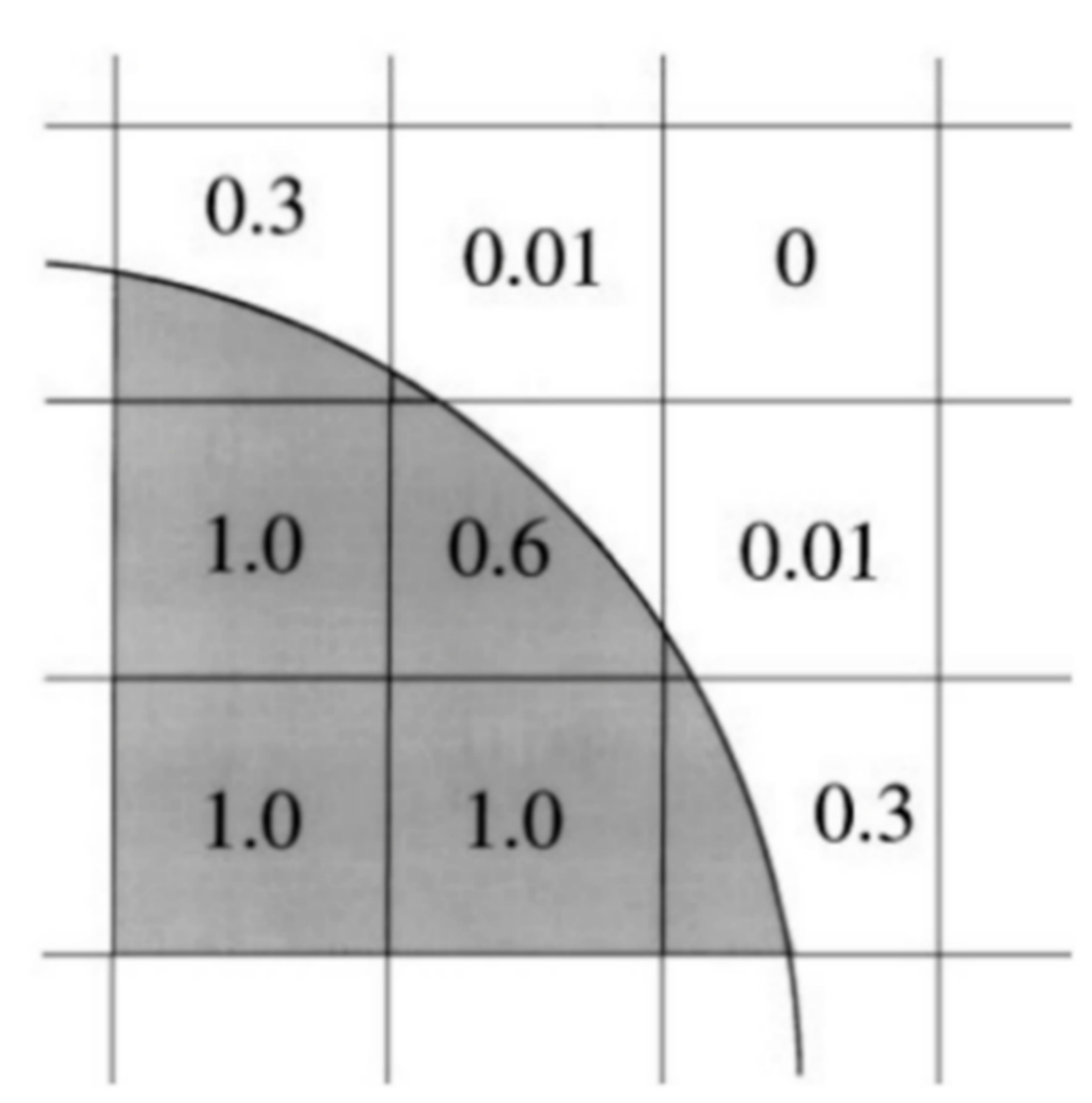
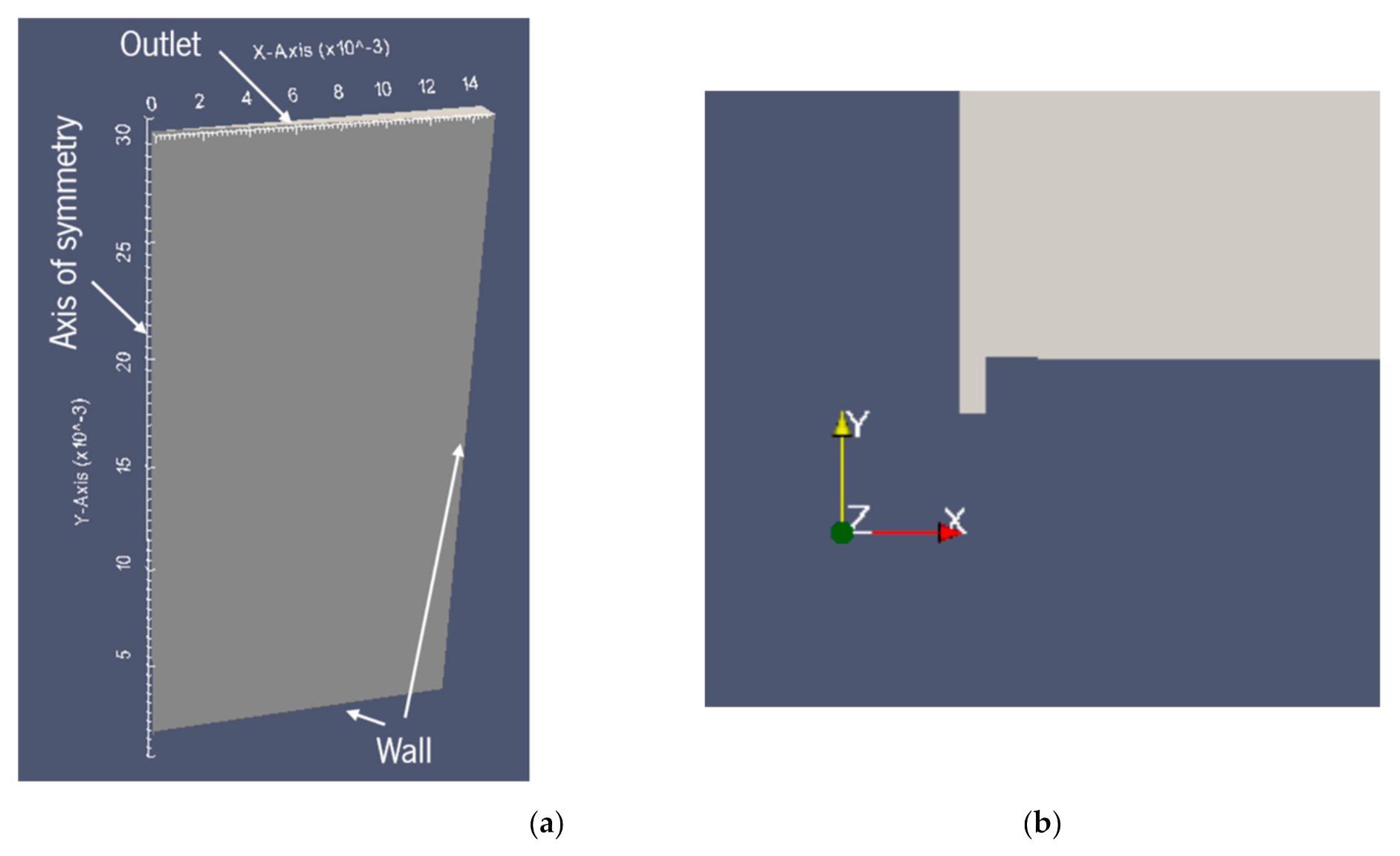
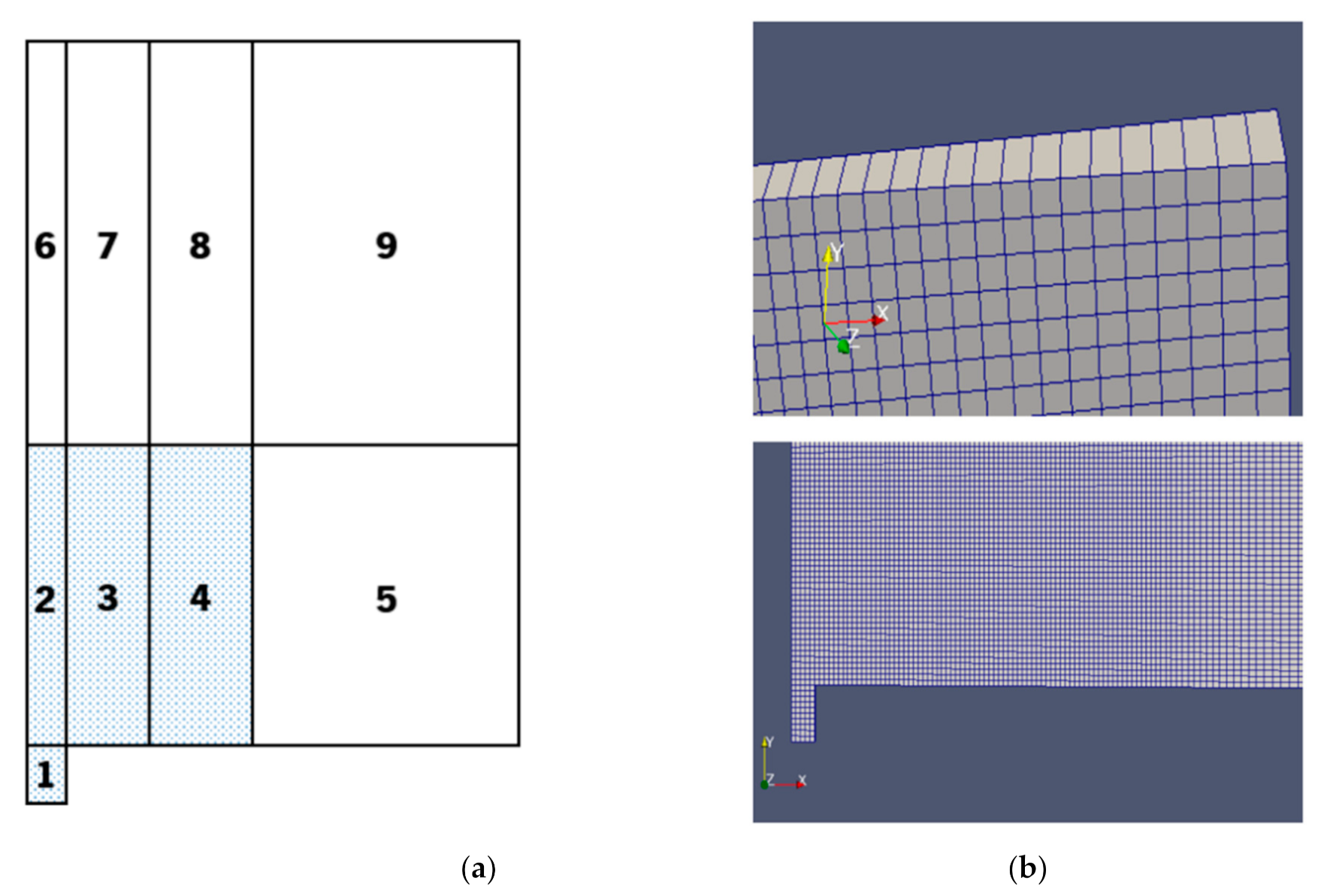
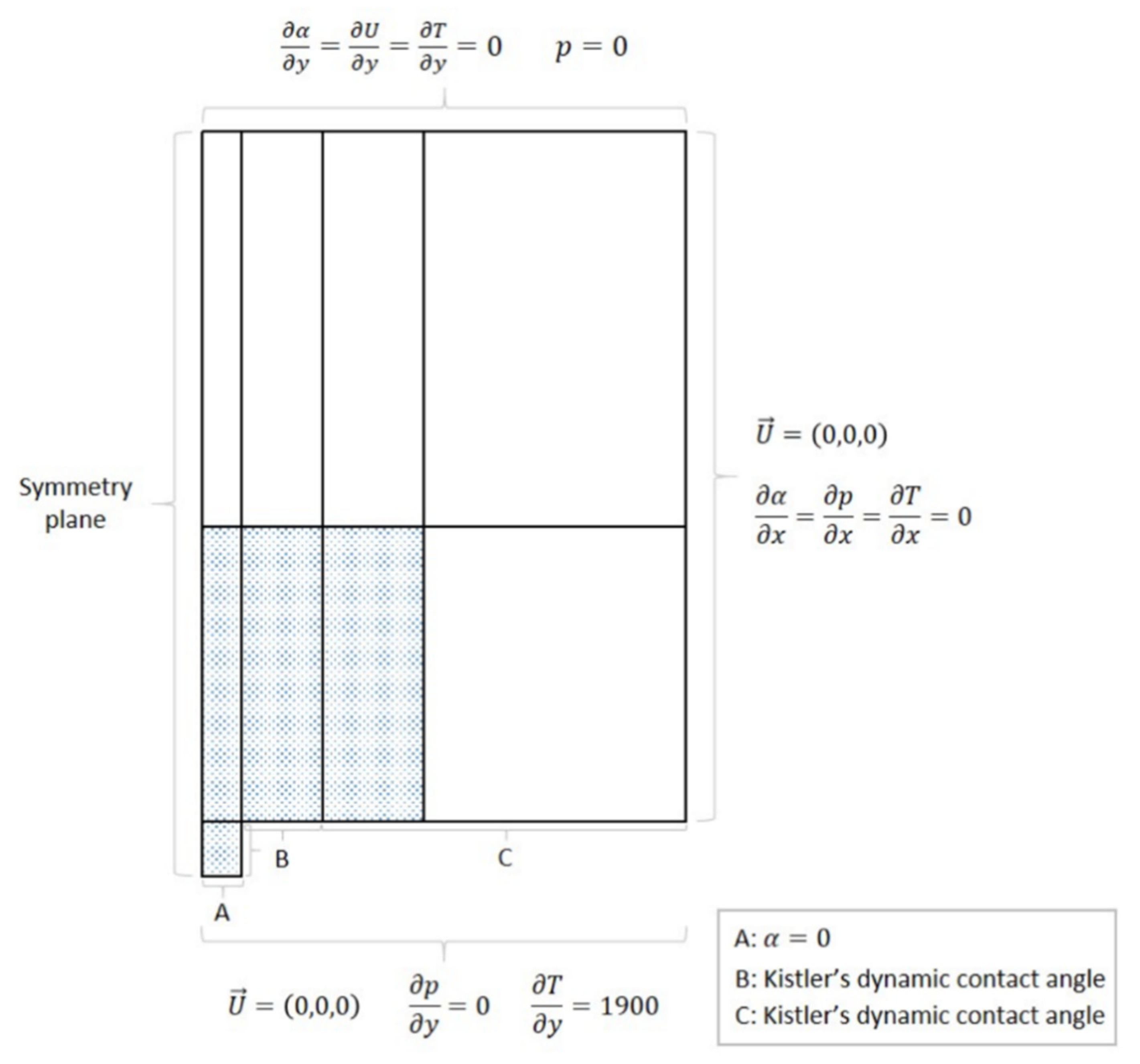

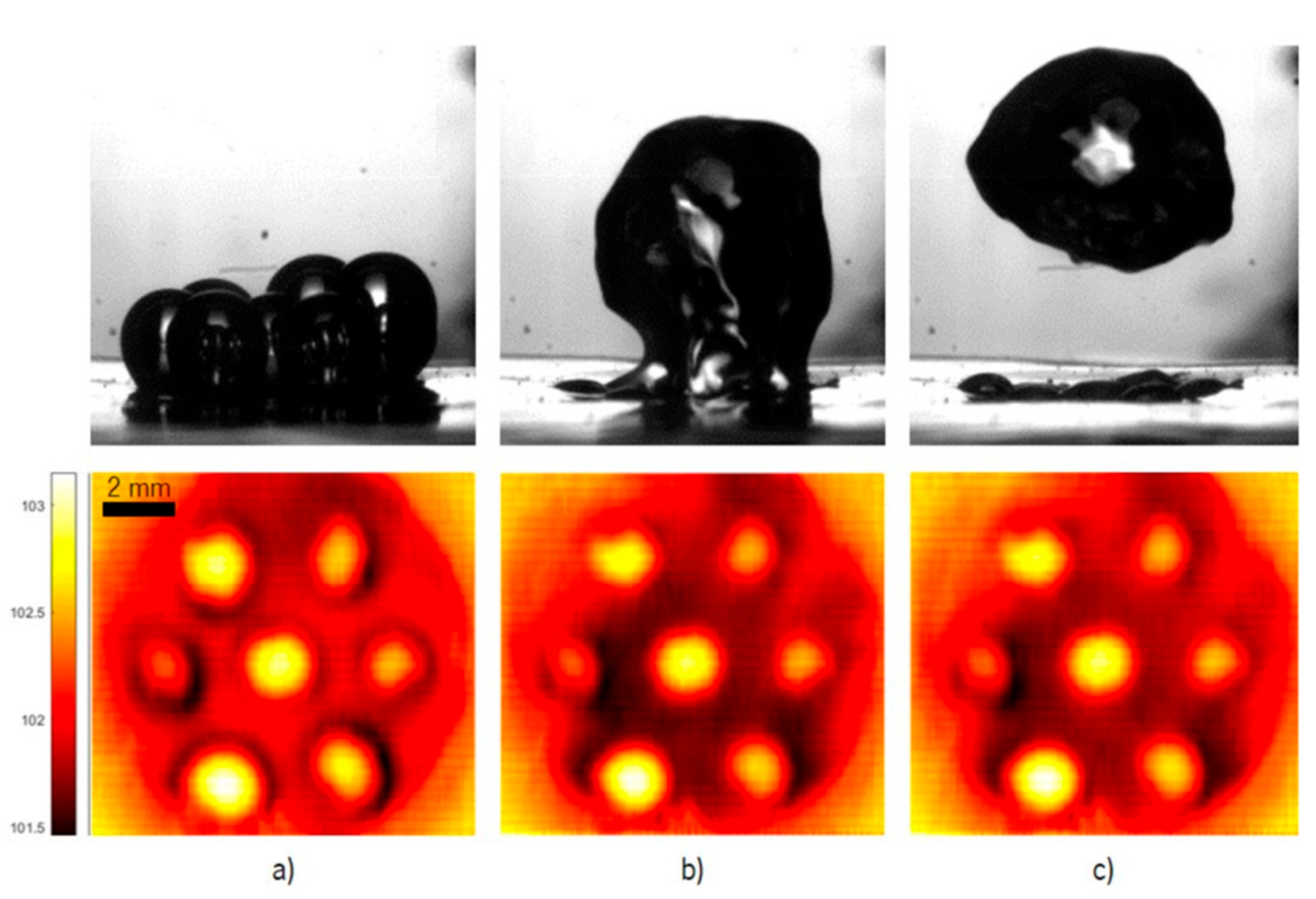
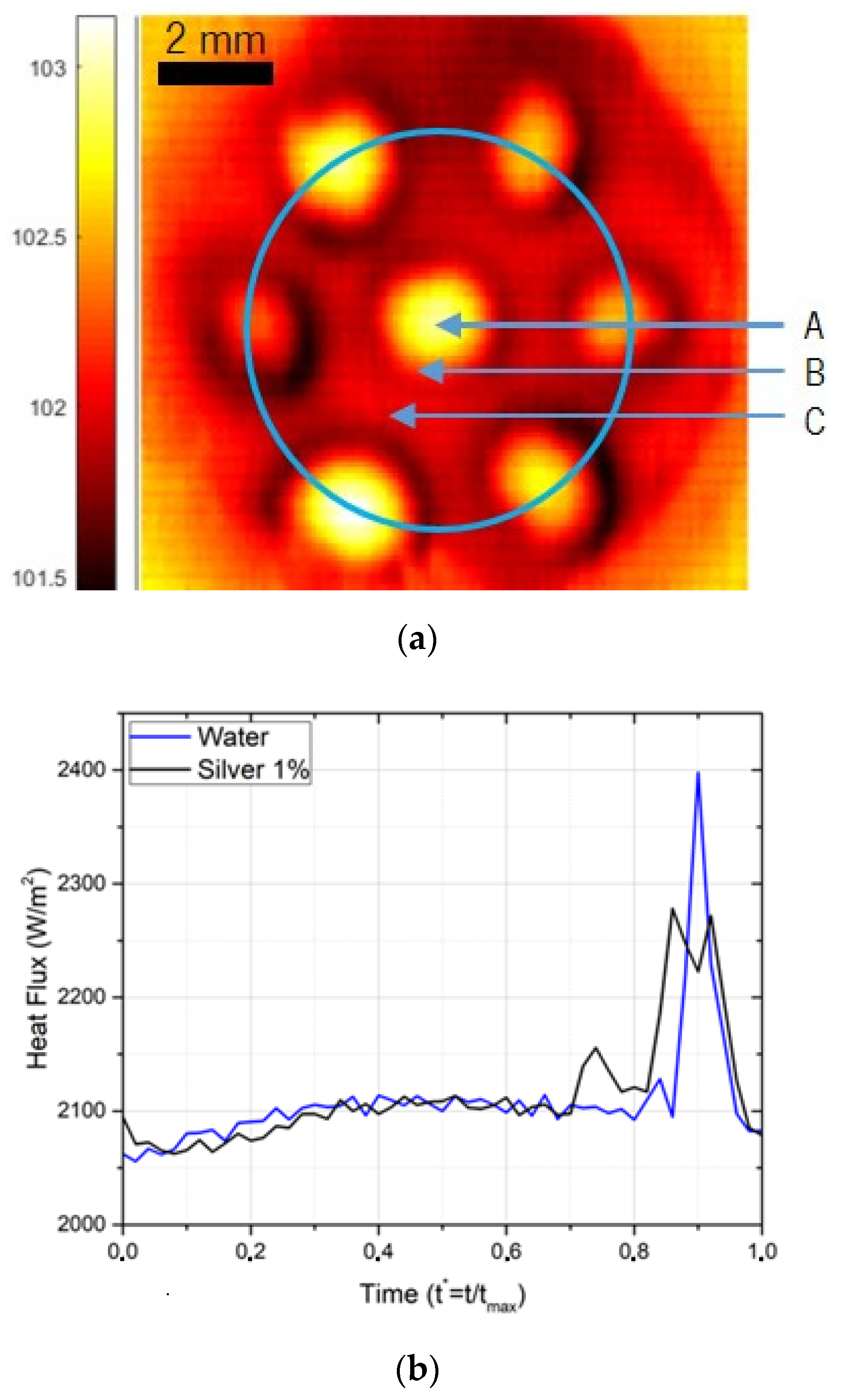
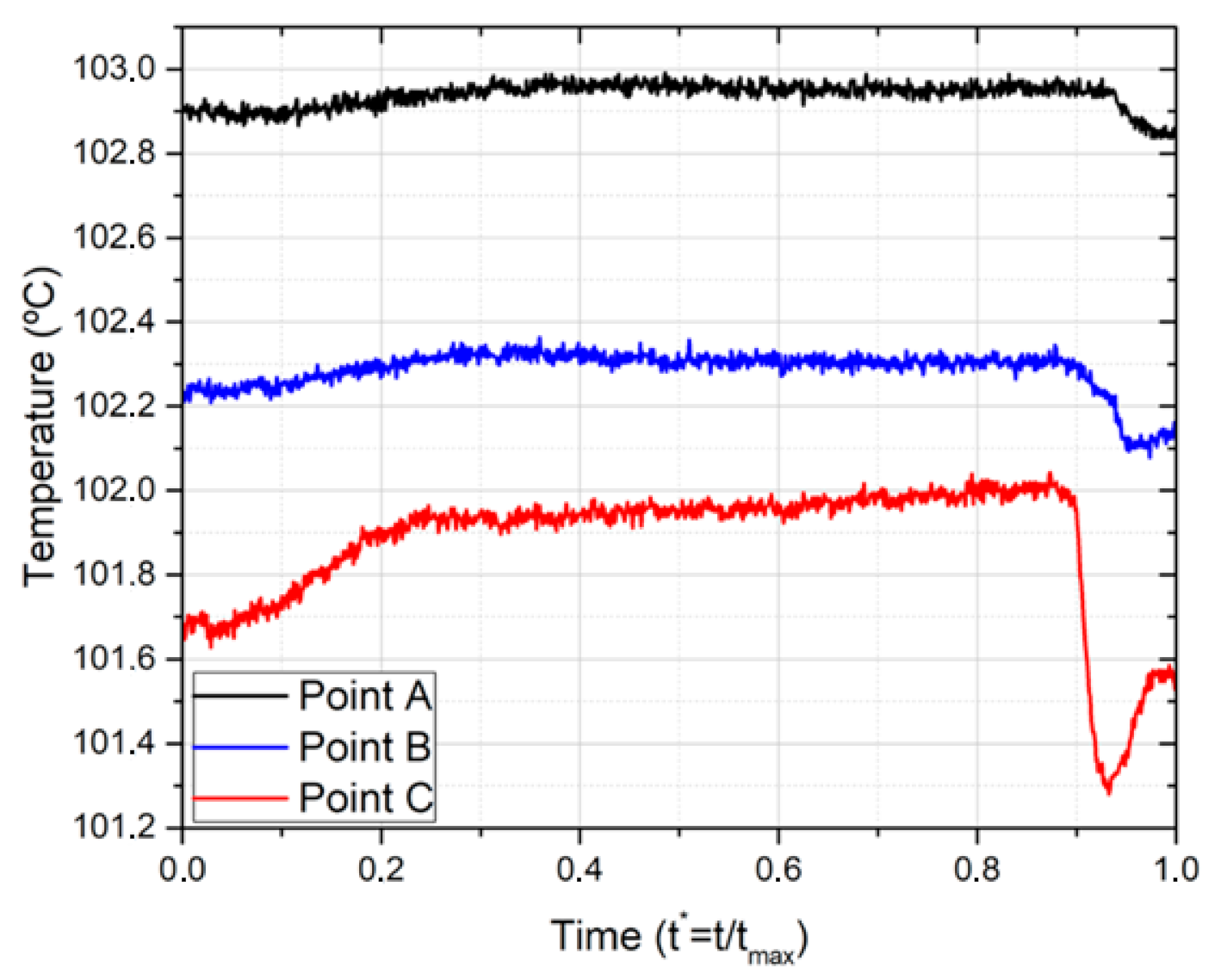
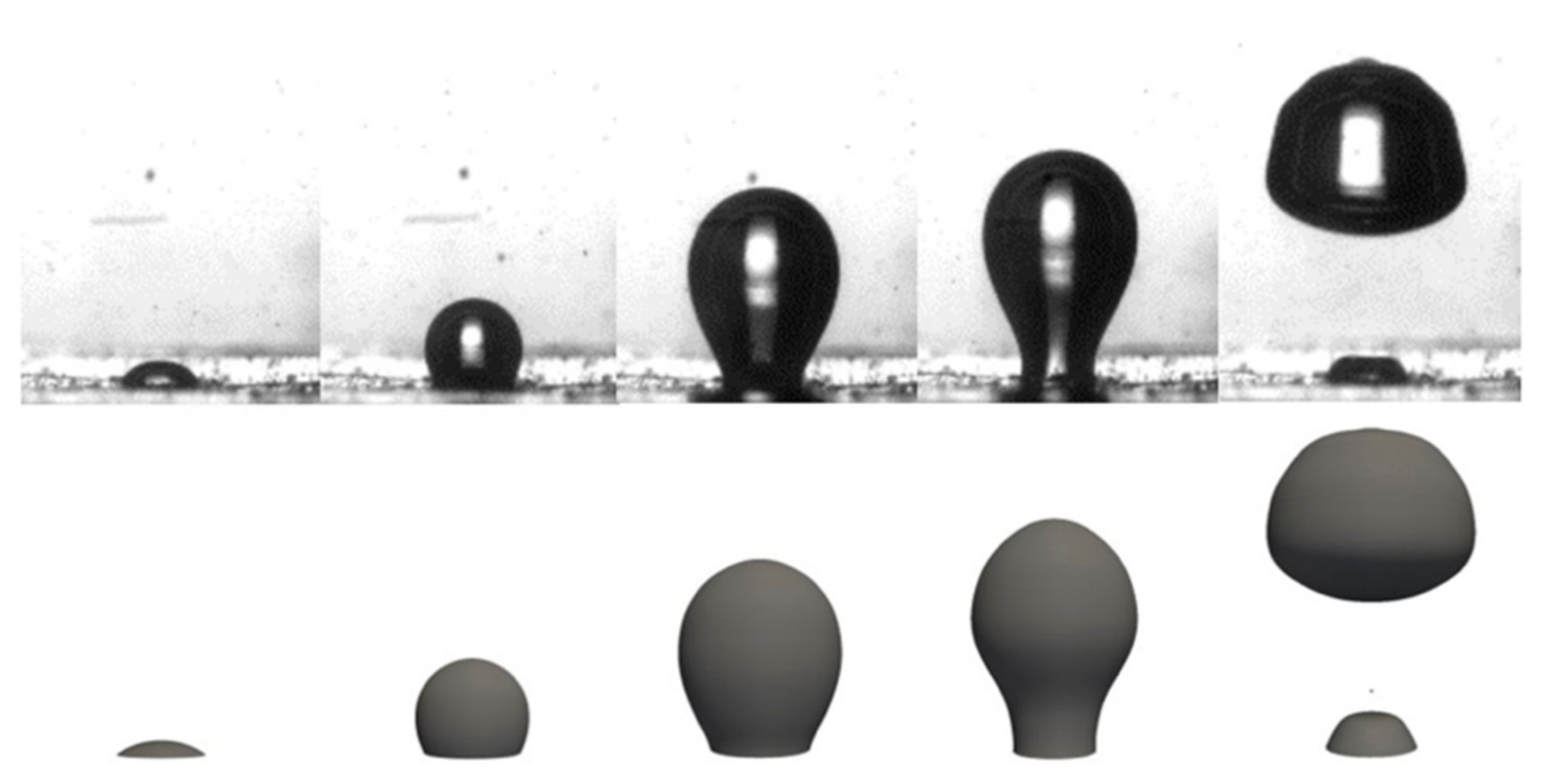
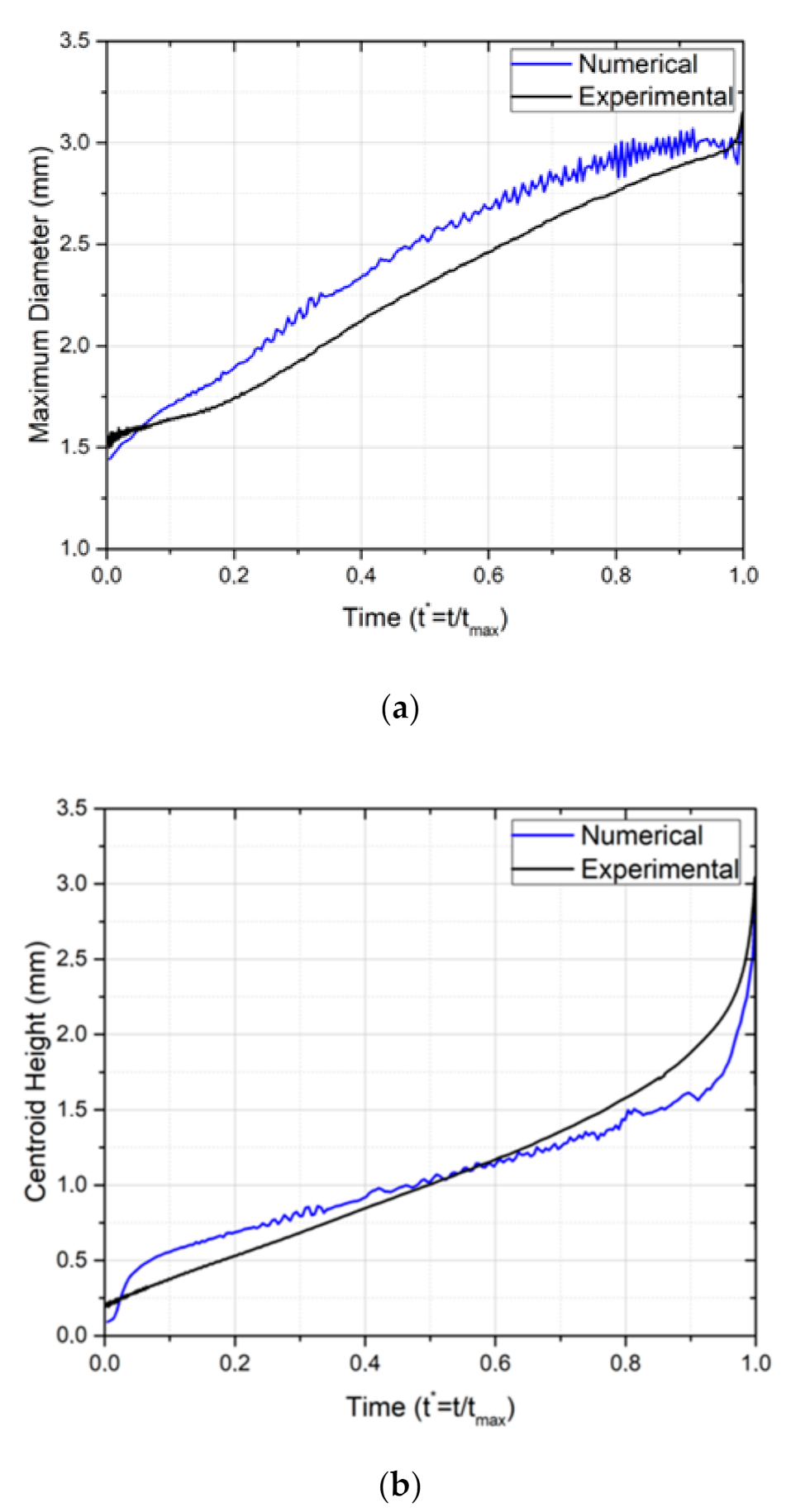
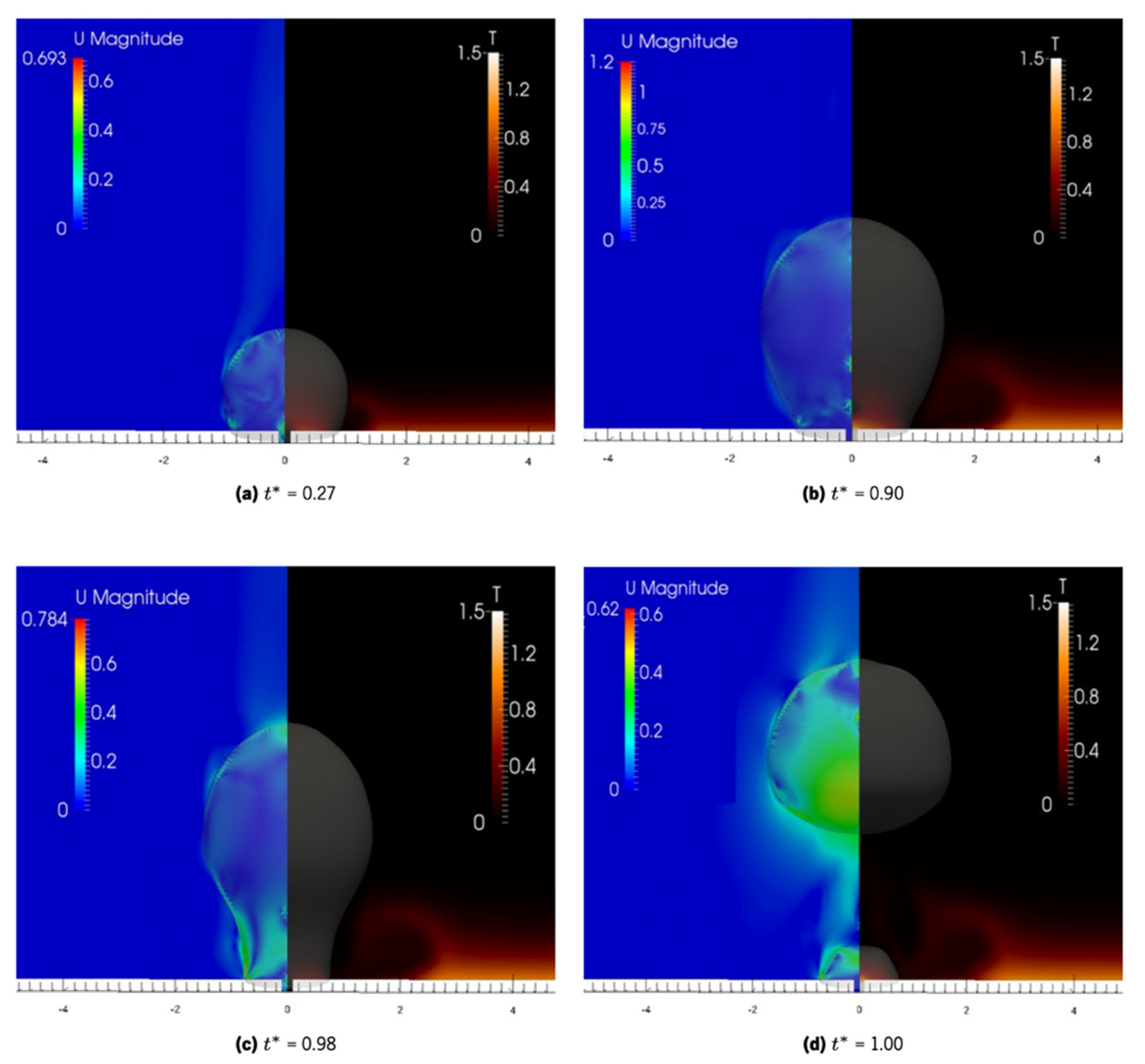
| Fluid | Density ρ [kg/m3] | Heat Capacity cp [kJ/kg·K] | Surface Tension σ [mN/m] |
|---|---|---|---|
| Pure Water | 958.2 | 4.22 | 71.6 ± 1.3 |
| Gold 0.1% | 959.2 | 4.21 | 69.7 ± 3.4 |
| Gold 0.5% | 962.9 | 4.20 | 74.7 ± 4.3 |
| Silver 0.5% | 962.7 | 4.20 | 70.9 ± 2.6 |
| Silver 1% | 967.3 | 4.18 | 72.8 ± 0.8 |
| Alumina 0.05% | 958.6 | 4.21 | 71.1 ± 3.1 |
| Aliminium 0.05% | 958.5 | 4.21 | 72.0 ± 7.9 |
| Fluid | Contact Angle Static (Advancing/Receding) θs (θa/θr) (°) | Hysteresis Δθ (°) |
|---|---|---|
| Pure Water | 161.8(160.7/159.5) ± 1.8 | 1.2 ± 2.2 |
| Gold 0.1% | 160.6 (162.3/160.1) ± 0.9 | 2.2 ± 0.7 |
| Gold 0.5% | 158.1 (159.1/157.1) ± 5.7 | 2.0 ±1.2 |
| Silver 0.5% | 160.1 (160.6/156.5) ± 0.3 | 4.1 ± 1.0 |
| Silver 1% | 159.7(155.6/153.0) ± 1.6 | 2.6 ± 0.4 |
| Alumina 0.05% | 161.0 (152.9/151.8) ± 2.4 | 1.1 ± 1.0 |
| Aluminum 0.05% | 162.3(160.6/157.4) ± 1.7 | 3.1 ± 2.2 |
| Fluid | Surface Tension σ (mN/m) |
|---|---|
| Pure Water | 71.6 ± 1.3 |
| Gold 0.1% | 69.7 ± 3.4 |
| Gold 0.5% | 74.7 ± 4.3 |
| Silver 0.5% | 70.9 ± 2.6 |
| Silver 1% | 72.8 ± 0.8 |
| Alumina 0.05% | 71.1 ± 3.1 |
| Aluminum 0.05% | 72.0 ± 7.9 |
| Property | Value |
|---|---|
| Flux (m2/s) | 2.02 × 10−5 |
| Density (kg/m3) | 0.60 |
| Conductivity (W/m.K) | 0.03 |
| Heat Capacity (J/kg.K) | 2029 |
| Surface Tension (N/m) | 0.06 |
| Heat Transfer (kJ/kg) | 2257 |
Publisher’s Note: MDPI stays neutral with regard to jurisdictional claims in published maps and institutional affiliations. |
© 2021 by the authors. Licensee MDPI, Basel, Switzerland. This article is an open access article distributed under the terms and conditions of the Creative Commons Attribution (CC BY) license (http://creativecommons.org/licenses/by/4.0/).
Share and Cite
Freitas, E.; Pontes, P.; Cautela, R.; Bahadur, V.; Miranda, J.; Ribeiro, A.P.C.; Souza, R.R.; Oliveira, J.D.; Copetti, J.B.; Lima, R.; et al. Pool Boiling of Nanofluids on Biphilic Surfaces: An Experimental and Numerical Study. Nanomaterials 2021, 11, 125. https://doi.org/10.3390/nano11010125
Freitas E, Pontes P, Cautela R, Bahadur V, Miranda J, Ribeiro APC, Souza RR, Oliveira JD, Copetti JB, Lima R, et al. Pool Boiling of Nanofluids on Biphilic Surfaces: An Experimental and Numerical Study. Nanomaterials. 2021; 11(1):125. https://doi.org/10.3390/nano11010125
Chicago/Turabian StyleFreitas, Eduardo, Pedro Pontes, Ricardo Cautela, Vaibhav Bahadur, João Miranda, Ana P. C. Ribeiro, Reinaldo R. Souza, Jeferson D. Oliveira, Jacqueline B. Copetti, Rui Lima, and et al. 2021. "Pool Boiling of Nanofluids on Biphilic Surfaces: An Experimental and Numerical Study" Nanomaterials 11, no. 1: 125. https://doi.org/10.3390/nano11010125









